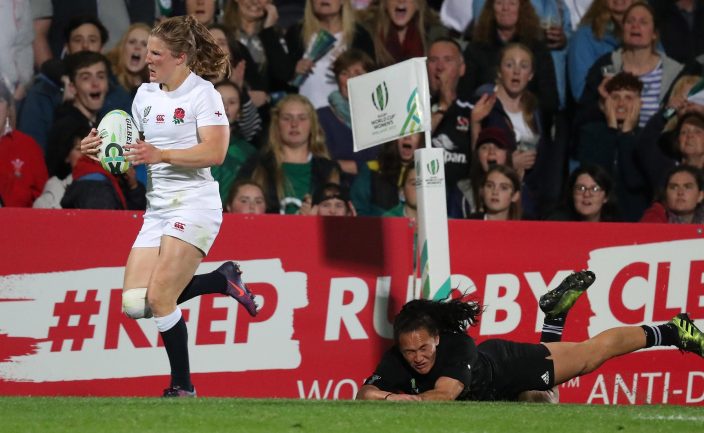USA Rugby has really gone upmarket on the latest version of the Super Series. Gathering together the top five ranked nations means this tournament represents the biggest showcase for women’s 15s rugby ever staged outside the World Cup.
And it helps to bridge that lengthy four-year gap. For three of the competitors, Canada, New Zealand and the hosts, it adds vitally needed international exposure for their players. For France and England it offers an extra edge of quality over the Six Nations.
The programme comes as close to the pattern of a WRWC as possible. With an odd number of contestants one team has to sit out each round; but these are scheduled every four days. World Rugby hasn’t yet made crystal clear whether the extra time-span of the New Zealand World Cup (35 days instead of 23) allows a wider gap between pool matches as well as the knock-out stages. ‘Four days between pool matches’ is open to two readings. It’s in those early rounds where more breathing space is desperately needed, especially for the less well established nations.
The full programme (the first four days all at Chula Vista):
Friday, June 28
Canada v New Zealand
England v USA
France sit out
Tuesday, July 2
France v Canada
New Zealand v USA
England sit out
Saturday, July 6
France v New Zealand
Canada v England
USA sit out
Wednesday, July 10
England v France
Canada v USA
New Zealand sit out
Sunday, July 14 (at the Torero Stadium, San Diego State University)
France v USA
New Zealand v England
Canada sit out
For the third time running England seem to have drawn the longest straw. For the International Series in New Zealand in June 2017 they faced first Australia (world ranking 6th), second Canada (3rd) and last the hosts (1st). At the last World Cup it was Spain, Italy, USA, France and New Zealand – a steady climb up the ranking lists to the very top.
Here in Southern California the Red Roses face the hosts first, Canada second, France third and – can you guess? – the World Champions last – almost a steady climb up the ranking lists to the very top – again.
Anyone would think that an English hand was responsible for this arrangement!
New Zealand will be delighted to add these fixtures to their schedule. With the two-test Laurie O’Reilly Memorial Trophy series against Australia in August they add up to a sterner preparation for the home World Cup than in the past.
The Black Ferns have a record unparalleled in women’s rugby: just eleven losses since their first test in 1991! Till recently they may have felt they didn’t need regular international competition: their internal levels of performance were enough to ensure victory over all-comers. But now they are aware that standards are rising alarmingly elsewhere, not least with the introduction of professional contracts.
Canada and the USA have both been short of international competition. During the lapse of the Super Series (the years 2017 and 2018) they have fallen behind. The two head coaches, Sandro Fiorino and Rob Cain, know how important this occasion will be to accustom their players to the high standards they will meet in 2021.
For Fiorino it will be the chance to maintain the Maple Leafs third place in the rankings. They lie a minute 0.13 points ahead of France. Both languish a distant six points behind England, but both have targets set well beyond those mere figures.
Karen Paquin is fit again. That’s excellent news for her team-mates, less so for opponents charged with keeping her in check; she’s been missing nearly two years.
She returns to the 7s squad, which leaves the same old question: will any of that distinguished group (Benn, Farella, Landry, Moleschi, Williams, etc) be available for the 15s game?
An important door has opened down the street: Toronto Arrows have become the first Canadian team to turn pro; they play in the North American Major League. Now for the women.
For Cain it will be a watershed: how far can he translate his new collection of hopefuls into the side he knows the Eagles can become? They produced some stunning rugby at the Irish World Cup. Just a lack of experience at the top level prevented them from going all the way. Cain and Emilie Bydwell, the US General Manager for Women’s High Performance, have set stiff targets for their new group, deprived of the stars claimed by the 7s squad. They are aiming at a top-2 world ranking, no less. To that end the Eagles have already taken on those top-2 nations last autumn. Though they were soundly beaten, they and their bosses know the sky’s the limit.
Their ambitions are marked by this cleverly conceived tournament.
France are in a state of flux. We must assume they will stick to their current policy of separating the 15s from the 7s squad. Like England, they know how difficult this can be. At present their 7s players are producing the results; for England the reverse is the case.
Their one simple target is to win the next World Cup, but this represents a psychological barrier. They have now reached seven semi-finals: not once have they taken the crucial step beyond to a final.
The programme isn’t as favourable to them as to the English. They sit out the first round; play the outsiders next, then come face to face with the world champions – quite a sequence.
England: it will be fascinating to see what squad size operates here. It’s nearly a year since WR announced that a rise from 28 to 30 players per nation would be permitted. But it’s hard to find a single example of a 30-strong squad being picked anywhere in the world thus far.
This has a particular importance for the Red Roses. This American adventure is another chance for them to present their credentials for having their contracts extended. During the 6 Nations the management selected largely on quality. Individual playing times ranged from the maximum, 400 minutes, right down to a quarter-of-an-hour for two players – and one of those is on a full contract.
Whoever is chosen for the touring party, it leaves either five or seven players at home twiddling their thumbs. It is possible that players could travel as non-playing reserves, as happened at the 2016 Olympics, but that is highly unlikely. Even if the full complement of 30 travel, that leaves seven players out of any 23 selected for each game. If a similar selection process operates, it’s possible that certain players will enjoy minimal input.
There are precious few fixtures where the selectors can be confident of putting out a less than full strength XV. Only the USA come to mind. Canada are likely to be even stronger than they were at Doncaster. The other two participants are daunting threats.
England have every right to think they can regain top spot, which they held briefly in June 2017. The way the ranking system works means they can only achieve it by beating the Black Ferns. Their outstanding victory 29-21 in Rotorua was undone by their loss in the World Cup final two months later.
It is a mighty challenge: of the 26 times they’ve met, England have won just 8. But that is eight times more than any other nation (See below).
Winning that final leg of the coming tournament will be the holy grail. The breadth and quality of the current squad, plus their exalted professional status, means they have most essentials in place to down the champions again. Of the long-term injured Lydia Thompson and Lagi Tuima are happily restored. Let’s hope the other missing players during the past months, Ellena Perry, Zoe Aldcroft and Justine Lucas, will be fit and raring to go.
Just to cheer the rest of the world up, here are the eleven losses the Ferns have suffered over twenty-eight years:
NZ 0 USA 7 – 1991
NZ 17 E 22 – 2001
E 10 NZ 3 – 2009
E 10 NZ 0 – 2011
E 21 NZ 7 – 2011
E 16 NZ 13 – 2012
E 17 NZ 8 – 2012
E 32 NZ 23 – 2012
Ireland 17 NZ 14 – 2014
NZ 21 E 29 – 2017
France 30 NZ 27 – 2018
And then there’s the strange case of the friendly between France and New Zealand played out at the tail-end of the first World Cup of 1991. At that tournament there were no play-offs to establish ranking positions. These two nations, the losing semi-finalists, agreed to play an extra match. Guess who won. The final score: 3-0. And New Zealand have never accepted that game as an official international. One of the French players was a certain Annick Heyraud.









